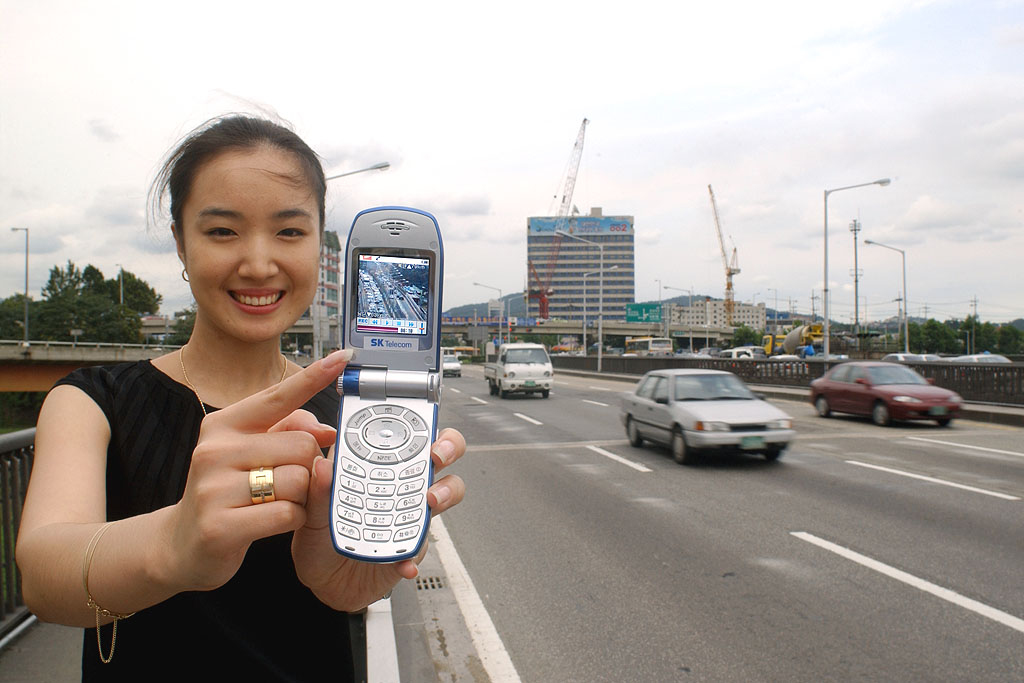content area
Press Release
The car drivers’ convenience has been greatly increased by the additional provision of VM-based traffic information.
The traffic information service area will be expanded from 11 regions to about 50 regions.
"Upon clicking the icon, the streaming video of "Freeway" is shown on the cellular phone"
Traffic information services offered on the cellular phone keeps evolving.
SK Telecom (www.sktelecom.com) announced the launch of the Virtual Machine (VM)-based traffic information service starting on the 13th of August. Now, the customer who uses traffic information through a cellular phone, can easily use the service by the icon mode.
The VM-based traffic information service allows car drivers to minimize the operation of terminals by previously downloading the program that enables users to directly access traffic information from a cellular handset. This service also lets users figure out the entire traffic situation of roads, or regions, through a variety of graphic data.
The conventional traffic information service in the metropolitan area covered 11 areas by providing streaming video via 6 CCTV on 5 bridges of the Han River, and at other major traffic congestion areas. The service area of VM-based traffic information has been greatly expanded to about 50 areas. This includes 19 bridges of the Han River, 18 major tunnels, 6 main highways, and 7 main roads (Kangnam Main Road, Yangjae Main Road, Youngdong Main Road, etc.) in the metropolitan area.
In the case of traffic information on the expressway, users are able to figure out the traffic situation for each section of the outgoing and returning roads because the service shows the color sign of four traffic situations such as "Clear", "Slow", "Delay’, and "Congestion" on the cellular phone. When users choose a detailed section of the road, they can obtain the information on traffic speed between sections through CCTV’s streaming video of 10 freeways nationwide, and outside roads around Seoul, provided by the Korea Highway Corporation.
In order to download the program of VM-based traffic information service, users should connect NATE service (3.Game/ ?Playon’1.?Playon ’4.Information’6. traffic information) through 256 color-enabled handsets. When using WAP-enabled handsets, they should connect the NATE service (6.Location/Traffic/Travel/’3. Freeway Traffic Information or 4. Traffic Information in Metropolitan Area).
Users only pay packet rates when they download the program of VM-based traffic information service. In this case, an information use rate will not be charged. After the download, when users make an inquiry about traffic information, each written message information and frozen moving image will be charged 50 won and 80 won respectively. In addition, streaming video information will be charged 100 won.
Traffic information services offered on the cellular phone keeps evolving.
SK Telecom (www.sktelecom.com) announced the launch of the Virtual Machine (VM)-based traffic information service starting on the 13th of August. Now, the customer who uses traffic information through a cellular phone, can easily use the service by the icon mode.
The VM-based traffic information service allows car drivers to minimize the operation of terminals by previously downloading the program that enables users to directly access traffic information from a cellular handset. This service also lets users figure out the entire traffic situation of roads, or regions, through a variety of graphic data.
The conventional traffic information service in the metropolitan area covered 11 areas by providing streaming video via 6 CCTV on 5 bridges of the Han River, and at other major traffic congestion areas. The service area of VM-based traffic information has been greatly expanded to about 50 areas. This includes 19 bridges of the Han River, 18 major tunnels, 6 main highways, and 7 main roads (Kangnam Main Road, Yangjae Main Road, Youngdong Main Road, etc.) in the metropolitan area.
In the case of traffic information on the expressway, users are able to figure out the traffic situation for each section of the outgoing and returning roads because the service shows the color sign of four traffic situations such as "Clear", "Slow", "Delay’, and "Congestion" on the cellular phone. When users choose a detailed section of the road, they can obtain the information on traffic speed between sections through CCTV’s streaming video of 10 freeways nationwide, and outside roads around Seoul, provided by the Korea Highway Corporation.
In order to download the program of VM-based traffic information service, users should connect NATE service (3.Game/ ?Playon’1.?Playon ’4.Information’6. traffic information) through 256 color-enabled handsets. When using WAP-enabled handsets, they should connect the NATE service (6.Location/Traffic/Travel/’3. Freeway Traffic Information or 4. Traffic Information in Metropolitan Area).
Users only pay packet rates when they download the program of VM-based traffic information service. In this case, an information use rate will not be charged. After the download, when users make an inquiry about traffic information, each written message information and frozen moving image will be charged 50 won and 80 won respectively. In addition, streaming video information will be charged 100 won.


